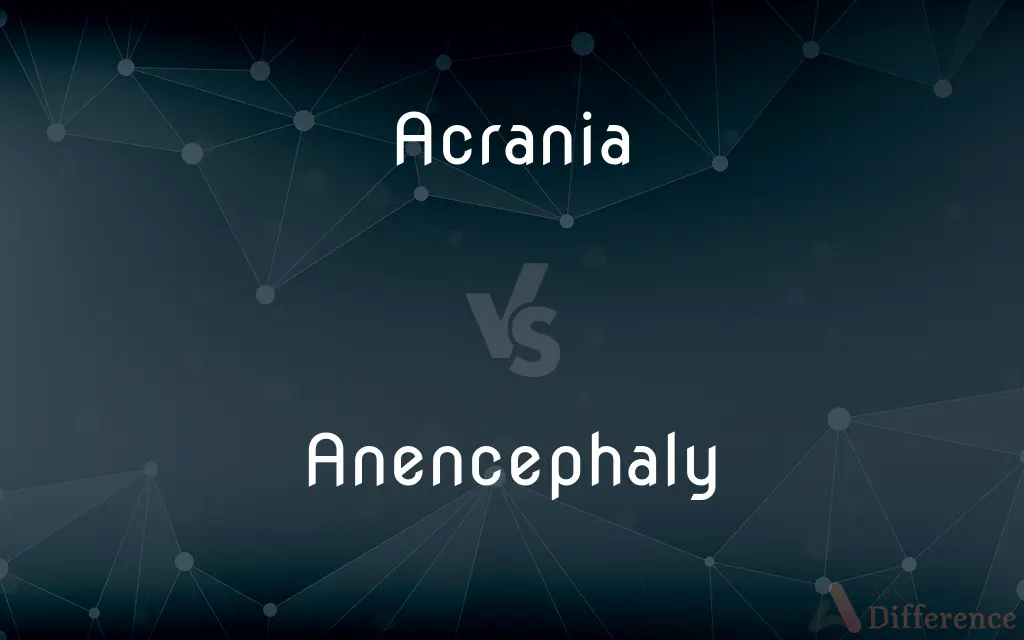Acrania vs. Anencephaly — What's the Difference?
By Fiza Rafique & Maham Liaqat — Updated on April 8, 2024
Acrania is a rare fetal condition characterized by the absence of the skull, with the brain generally present but not fully developed, whereas anencephaly is severe neural tube defect where a major portion of the brain, skull, and scalp does not develop.

Difference Between Acrania and Anencephaly
Table of Contents
ADVERTISEMENT
Key Differences
Acrania is an early developmental anomaly in which the flat bones of the cranial vault are missing, but the cranial base and facial bones are usually normal. This condition allows for the brain tissue to develop, although it is often abnormal and exposed. On the other hand, anencephaly involves the absence of a major portion of the brain, skull, and scalp. Occurring during embryonic development, it is considered one of the most severe neural tube defects. While both conditions result from abnormal neural tube closure, anencephaly is more severe, typically leading to stillbirth or death shortly after birth.
In acrania, the absence of cranial bones leads to the exposure of the cerebral hemispheres, which are not covered by bone or skin, making survival outside the womb virtually impossible. Whereas in anencephaly, the brain's development is so compromised that most of the brain tissue is missing, and what remains is often not covered by bone or skin. This distinction underscores the severity and outcomes of these conditions, with anencephaly being more uniformly fatal.
Diagnosis of acrania and anencephaly usually occurs via prenatal ultrasound, with both conditions detectable in the first trimester. However, the prognosis for each is grim, with no viable treatments to correct the defects. The emphasis is often on supportive care and counseling for the affected families. Despite the similarities in early detection and lack of treatment, the specific nature and prognosis of these conditions differ markedly.
Research into the causes of acrania and anencephaly focuses on genetic, environmental, and nutritional factors, with particular attention to folic acid deficiency during pregnancy. While the exact mechanisms leading to these conditions are not fully understood, the importance of prenatal care and nutritional supplementation is emphasized in preventing neural tube defects.
While acrania and anencephaly are related developmental conditions resulting from neural tube defects, they are distinct in their presentation, severity, and outcome. Acrania involves primarily the absence of the skull with some brain development, whereas anencephaly is characterized by the absence of significant portions of the brain and skull.
ADVERTISEMENT
Comparison Chart
Definition
Absence of the skull's flat bones with the presence of brain tissue.
Severe deficiency of the brain, skull, and scalp.
Brain Development
Brain tissue develops but is abnormal and exposed.
Most brain tissue is missing; severe neural development issue.
Skull and Scalp
Absence of cranial vault; base and facial bones usually normal.
Major portions of the skull and scalp are missing.
Outcome
Fatal; survival outside the womb is impossible due to exposure of the brain.
Uniformly fatal; typically leads to stillbirth shortly after birth.
Diagnosis
Detected via prenatal ultrasound, usually in the first trimester.
Similarly detected early in pregnancy through ultrasound.
Compare with Definitions
Acrania
Rare fetal condition lacking skull bones.
Prenatal testing can diagnose acrania early in pregnancy.
Anencephaly
Severe neural tube defect.
Anencephaly is one of the most severe neural tube defects, with significant brain absence.
Acrania
No treatment available.
There is no cure for acrania; management focuses on counseling for the parents.
Anencephaly
Leads to stillbirth or death after birth.
Babies with anencephaly typically do not survive long after birth.
Acrania
Involves brain tissue exposure.
In acrania, the brain is present but unprotected and exposed.
Anencephaly
Little to no brain development.
In anencephaly, the majority of the brain and skull do not develop.
Acrania
Outcome is fatal.
Babies with acrania cannot survive outside the womb due to the exposed brain.
Anencephaly
Diagnosis through prenatal care.
Anencephaly can be detected through routine prenatal ultrasounds.
Acrania
Detected via ultrasound.
Ultrasound images revealed the absence of the cranial vault, indicating acrania.
Anencephaly
Prevention includes folic acid.
Taking folic acid supplements during pregnancy can reduce the risk of neural tube defects like anencephaly.
Acrania
Acrania is a rare congenital disorder that occurs in the human fetus in which the flat bones in the cranial vault are either completely or partially absent. The cerebral hemispheres develop completely but abnormally.
Anencephaly
Anencephaly is the absence of a major portion of the brain, skull, and scalp that occurs during embryonic development. It is a cephalic disorder that results from a neural tube defect that occurs when the rostral (head) end of the neural tube fails to close, usually between the 23rd and 26th day following conception.
Acrania
(physiology) Partial or total absence of the skull.
Anencephaly
Congenital absence of most of the brain and spinal cord.
Acrania
Partial or total absence of the skull.
Anencephaly
A lethal birth defect in which most of the brain and parts of the skull are missing; absence of the encephalon.
Acrania
The lowest group of Vertebrata, including the amphioxus, in which no skull exists.
Anencephaly
A defect in brain development resulting in small or missing brain hemispheres
Common Curiosities
Can taking folic acid prevent acrania and anencephaly?
While not guaranteed, adequate intake of folic acid before conception and during early pregnancy can reduce the risk of neural tube defects.
What causes acrania and anencephaly?
Both conditions are caused by abnormal neural tube closure during early fetal development, influenced by genetic, environmental, and nutritional factors.
What is the difference in outcome between acrania and anencephaly?
Both conditions are fatal, but anencephaly is more uniformly fatal with most cases leading to stillbirth or death shortly after birth.
How are acrania and anencephaly diagnosed?
Both conditions are typically diagnosed through prenatal ultrasound, often in the first trimester.
Is there any hope of survival for infants born with these conditions?
Unfortunately, both acrania and anencephaly are considered incompatible with life outside the womb.
Can acrania or anencephaly be treated?
There are no treatments to correct these conditions; management focuses on supportive care and counseling for the families.
Are acrania and anencephaly genetic conditions?
While the exact causes are not fully understood, both conditions may have genetic components influenced by environmental and nutritional factors.
What is the main difference between acrania and anencephaly?
The main difference lies in the presence and development of brain tissue; acrania has some brain development but no skull, while anencephaly involves a significant absence of both brain and skull.
Can acrania develop into anencephaly?
Acrania and anencephaly are distinct conditions, but acrania can appear similar to anencephaly as pregnancy progresses due to the degradation of exposed brain tissue.
How common are acrania and anencephaly?
These conditions are rare, but anencephaly is among the more common neural tube defects.
Share Your Discovery

Previous Comparison
Chalk vs. Gypsum
Next Comparison
Authentication vs. AuthorizationAuthor Spotlight
Written by
Fiza RafiqueFiza Rafique is a skilled content writer at AskDifference.com, where she meticulously refines and enhances written pieces. Drawing from her vast editorial expertise, Fiza ensures clarity, accuracy, and precision in every article. Passionate about language, she continually seeks to elevate the quality of content for readers worldwide.
Co-written by
Maham Liaqat















































